It Goes On The Shelf
No.7 November 1990
Published at The Sign of the Purple Mouth by Ned Brooks
4817 Dean Lane, Lilburn GA 30047-4720
nedbrooks@sprynet.com
Website -
http://home.sprynet.com/~nedbrooks/home.htm

Cover art by Sheryl Birkhead
Bacover & p.10ff by Rick McCollum; Brad Foster art pp.6,7,9 & 13;
Scientifantasy art, see p.4; p.11 art by Chuck Ermatinger. [NB - Yeah, I know
the page numbers mean little in the HTML version.]
Hurricane Lily has passed us by and it's almost Halloween - even if it is in
the high 80s during the day - so it must be time to get started on this year's
issue. Will I still have a job when Congress gets done squabbling over the
budget? Is it so warm because the Greenhouse Effect has cut in? Who did kill
Laura Palmer? Is there any cover art in that big box where the IGOTS stuff
accumulates? I dunno, am I getting senile? Probably, but I can't tell, why
should I care?
One thing in the box is the typescript of a book by Mae Strelkov. This is the
third of seven books about her childhood as the daughter of missionaries in
China. She writes that her daughter in Canada has one book, and Buck Coulson
another. She's interested in having them published - anybody out there have any
ideas? I can make the text look sort of like a book, but promotion and
distribution are beyond me on a non-sf book.
Arthur Machen - Selected Letters ed. by Roger Dobson, Godfrey
Brangham, and R. A. Gilbert, Aquarian Press, Wellingborough, England, 1988
(distributed in the US by Sterling Pub. Co., NY). I just got this a few weeks
ago, I think my first order for it went astray, and I haven't finished reading
it yet. A long overdue book, and well produced, with a number of photographs of
Machen and his correspondents. The letters are arranged by correspondent, which
seems a logical way to do it, and the first section consists of 40 years of
letters to A. E. Waite. One rather misses having only one side of the
correspondence! You might think that letters dating back to the turn of
the century would make dull reading, but I found them fascinating. Most points
that would be obscure to the reader are well covered in the footnotes. The price
in pounds of the book is gives as 13.95, which would be about $24 from Sterling,
if it can actually be obtained from them. My copy was kindly sent by Rita Tait
at the Arthur Machen Society (19 Cross Street, Caerleon, Gwent, NP6 1AF, United
Kingdom), in exchange for some copies of Guinevere and Lancelot, the
Machen book I published nearly four years ago now - still in print though.
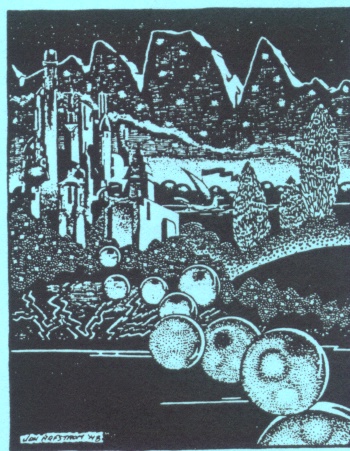
The Green Round Press (at the same address as the Machen Society, see above)
has just reprinted Strange Roads/With the Gods in Spring by Arthur Machen
in a very attractive hardcover. This is their first book, and the second, now in
preparation, is The Memoirs of Purefoy Machen. Purefoy was Arthur
Machen's wife, and this is the first I knew that she had written any memoirs.
These are limited editions (350 copies of Strange Roads ) and I don't
seem to have anything here that indicates the price. These two short essays (the
whole book is only some 50 pages) are published here for the fourth time, all
four of them quite limited editions. They are concerned with man's relationship
to God and Nature, in a very indirect way. They can be read with great pleasure
again and again, but don't expect to find any conclusion!
The Poor Mouth by Flann O'Brien, Picador/Pan, London, 1975.
Illustrated by Ralph Steadman. This used pb just came in from Diane Fox down
under in Down Under, who sents me odd books from time to time. It's hard to tell
how much of the peripheral material here is true and how much is part of the
joke! Flann O'Brien was one of the names used by Brian O'Nolan (the other
was Myles na Gopaleen) - even I knew that - and it says here that he wrote this
book in Gaelic as An Beal Bocht and it was published thus in 1941. The
Poor Mouth (the phrase apparently meant the same in Ireland as it does in
the Southern US) is the 1973 translation by a Patrick C. Power. But O'Brien (or
O'Nolan) wrote in English himself - so why a translator? And how is it that both
the title and the hero's name, Napoleon O'Coonassa both sound more
like they came out of New Orleans than Dublin? Well, it is said to be a
satirical novel - perhaps it would help if I had ever read whatever it is that
is being satirized! As it is, the life story of O'Coonassa and his
neighbors O'Bannassa and O'Loonassa seems rather pointlessly bizarre. The
Steadman illustrations are nice.
There must be some internationally distributed index that lists IGOTS as
being published by The Purple Mouth Press and gives my address - all
quite correct. But what do they say about it that induces people in Nepal and
Iran and Bulgaria to write and ask for a copy, and after I send one, I never
hear from them again? What were they expecting? The latest such request comes
from Mohsen Roshani, a `Senior Adviser' at "Tabage Yek" in Tehran, Iran. If any
of you librarian types out there know how IGOTS is listed internationally,
please send me a photocopy.
Out of curiosity I actually wrote to a few of the addresses listed in that
massive compilation of weirdness, Factsheet Five - Gunderloy could be
making it all up, right? One of the things that appeared in my mailbox was
Dyslexic Catalog (Box 4763 Boulder, CO - 80306). I'm glad to see that
DaDa is alive and well - as long as I don't have to try to understand it.
Winterlong by Elizabeth Hand, Bantam/Spectra, NY, 1990, $4.95, 442pp. I
suspect, judging from the author's explanation of why she wrote it, that I
enjoyed this novel for all the wrong reasons! So sue me... It's a first
novel (a sequel is in progress, to be called Aestival Tide ), with a
bizarre and complex plot and an excellent (if occasionally obsessively
repetitious) poetic style. The characters are rather psycho-sexual cyberpunk and
the motivation not always clear, but the language and the plot flash right
along.
Having lived in Chile as a child (age 8-15), I was curious when I ran across
an address for a fanzine published there - Nadir, edited by Moises Hasson
C. (Casilla 3657, Santiago, Chile) - and sent a copy of IGOTS offering a trade.
Nadir (I recieved #9, published in Oct'88) is very much a typical genzine
of the sort seen here in the 70s and 80s. Some 68 pages offset from typescript,
about digest-size, all in Spanish. I can read Spanish well enough to get the
sense of it, but not well enough any more to enjoy it as literature - it has
been nearly 40 years since I read most of the Tarzan books in an Argentine
edition. Reviews, fiction, essays and so on. The interior art is competent, and
the cover (to which I can find no reference as to what is depicted) is
excellent. The back cover is by the famous British illustrator W Heath Robinson,
apparently from a pirated source, as his signature had been removed before
Hasson copied it, but probably in the public domain now anyway, as it is at
least 70 years since the original publication. A note from Hasson says that he
finds IGOTS `strange' - well, I do my best... "Nadir" means the same in Spanish
as in English, the opposite of `zenith', but the choice of title is not
explained.

The Year of the Pigeons by John Moore, Collins, London, 1963.
Illustrations and d/w by John Lawrence, 160pp. I think this is one of the books
Richard Dalby sent me, but quite a while back. I ran across it in the bookcase
by the bed and, like all of John Moore's books that I have read, enjoyed it very
much. It's an account of what he saw of his corner of Gloucestershire,
travelling mostly on horseback. Natural history, antiquities, local characters,
the effects of modern chemical idiocies - great writing. I was intrigued to note
a few typographical errors - rare in British books - which seemed to be of the
sort that would be made setting type by hand. And yet the book is a mass-market
(Moore is very popular in England) production from the 60s and sold for 18s,
certainly less than $5, so it could hardly be letterpress.
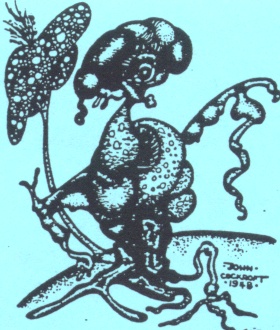
I guess I'm just not in the mainstream of fanzine fandom any more - if I ever
was. When I did It Comes in the Mail I certainly got more fanzines than I
could shake a stick at (what an idiotic old idiom! ), but now I only hear
about things later, and lucky to get them if at all. One such was the final,
posthumous issue of Terry Carr's Innuendo (#12), which I particularly
wanted for my Hannes Bok collection as it has a Bok cover completed by my old
friend Steve Stiles. But it's a great zine altogether, full of delightful idiocy
and great fanart on the traditional TwilTone. You might still get a copy if you
sent $6 to Jerry Kaufman, 8738 First Avenue West, Seattle, WA - 98117. Find out
what Walt Willis did to the Magna Carta...
Another fanzine I finally got and enjoyed very much is The Enchantment
, Walt Willis' account of his trip to the US to be GoH at the 1988 TropiCon in
Ft.Lauderdale.
Across The Wounded Galaxies - Interviews with Contemporary American
Science Fiction Writers, ed. by Larry McCaffery, Univ. of Illinois Press,
Urbana. What a great title, eh? And it's a nice d/w too, which is about all I
can tell you. The d/w is all I have, and it doesn't even include a price. The
writers listed are Benford, Burroughs (William), Butler, Delany, Disch, Gibson,
LeGuin, Russ, Sterling, and Wolfe (Gene).
Dainis Bisenieks, who works for Owlswick Press, sends a handscrawl early
draft of the jacket copy for a new "Dr. Eszterhazy" book by Avram Davidson -
something to look forward to! A California Dreamer in King Henry's
Court by Robert C. Plunkett, Silver Dawn Media, Simi Valley, CA, 1989,
$16.95, 213pp 8vo hardcover in d/w by Tim Solliday. I don't like the dead-white
paper, but the simulated leather binding is nice, and the d/w art is excellent.
This is the first I had heard of Plunkett or Silver Dawn, but there is an
endorsement on the back of the d/w by A. E. Van Vogt. They had my address from
somewhere and sent a copy of the d/w, which was mangled by the PO in an odd way,
so I asked for a review copy. The full address is 2828 Cochran St., Suite 301,
Simi Valley, CA - 93065, and they ask for $1.75 p&h.
Why use a title
that is an obvious pastiche from the famous Mark Twain novel? It is a
time-travel fantasy, and it has some wit and social commentary. Twain it isn't,
of course, and the author needs a better editor, but I must admit the thing kept
me up too late reading it. The beginning is much the stronger part, a bit like
something by John Bellairs, and the ending is very weak, really just a stop with
no resolution. Perhaps a sequel is planned.
Art notes - [1] We take no responsibilty for damages caused by attaching a
bookshelf to a wall as shown on the cover... [2] The Scientifantasy art, (see
p.12) is by Jon Arfstrom (pp.2,5), Joe Krucher (pp.3,9),John Cockroft (p.4),
Jack Gaughan (p.8), and Hannes Bok (p.12).
I might mention that this book has an annoying number of the sort of
typographical errors that are only caused by computer typesetting. Whether these
are due to operator error or computer glitches I cannot tell. I am only really
familiar with the old FancyFont that this zine is set in, but I have used TeX at
work some. Perhaps because of this and the fact that I read in bed with my
glasses off (I am very nearsighted) I notice these things more than the average
reader would.
I Was Robot (Utopia Now Possible) by Ernest Mann, Little Free Press,
Cushing, MN, 1990, wraps, 320pp. This pb sells for $7.95 from Rt.1,Box 102,
Cushing, MN-56443. This is a mixture of philosophy, autobiography, and his own
peculiar economic theory. Quite well written at the sentence and paragraph
level, it is rather chaotic in overall structure. "Ernest Mann" is not his real
name, and the book is specifically not copyrighted. He is said to have made
enough money in some unspecified business to retire at the age of 42, and has
since devoted his time to philosophizing and his bizarre proposal for a economic
utopia in which all goods and services would be free and everyone would work for
nothing. I pointed out to him years ago that, besides the difficulties with this
inherent in human nature, the capitalist economic system, with all its faults,
works because it is also an information system - that is, for example,
the production of Cadillacs is regulated by the feedback data on the number of
people willing to pay that much for a car.
Mann also has some interesting
conspiracy theories. He speculates, for example, that the popularity of violent
movies is due to promotion by a deliberate conspiracy between Hollywood and the
Government with the intent of inducing a high enough level of paranoia in the
populace to suppress rebellion. I find this no more unlikely than my own theory
that Hollywood and the tobacco companies were in collusion from the 1930s on to
promote smoking by making sure that all the role-model characters in
contemporary films were inevitably to be seen puffing away on cancer sticks.
Project Pride is a community effort in Cross Plains, Texas, to
preserve the Robert E. Howard home as a local heritage museum that would also
display Howard memorabilia. Contributions should be made payable to "Friends of
the Library" and sent to Project Pride, Box 534, Cross Plains, TX - 76443.
Deborah Laine-Felts, a modern woman with no apparent address (on this sheet -
maybe there was something on the envelope I have discarded long since) but both
a phone (201-445-3450) and a fax (201-445-2924) notifies me that `Golden Age'
comic books are now available on color microfiche at, it seems, under $6 each,
maybe. Sounds like a great thing if that's what you are into, though I must say
that every microfiche reader I ever tried to use was a snare and an abomination.
Writers of the Future, Vol.VI, ed. by Algis Budrys, Bridge
Publications, Los Angeles, 1990, wraps, 409pp, illustrated by divers artists
under the direction of Kelly Freas. A $4.95 mass market pb with a Frazetta
cover. The interior art is quite good, however. I must admit I haven't gotten to
the stories yet.
You probably didn't see it in your local fishwrapper, but after ten years of
expensive litigation, the `Plowshares Eight', who entered a GE plant in King of
Prussia (!), Pa., and symbolically damaged some nuclear missile nosecones, were
found guilty and sentenced to `time served' (awaiting trial) - about 23 months
each. The judge admitted that he finally came to believe that the defendants
were sincere in their anti-war convictions. He must be rather slow - since the
facts of the event were never in dispute and there was no concievable way the
defendants could profit personally from their actions, what other motive could
there have been?
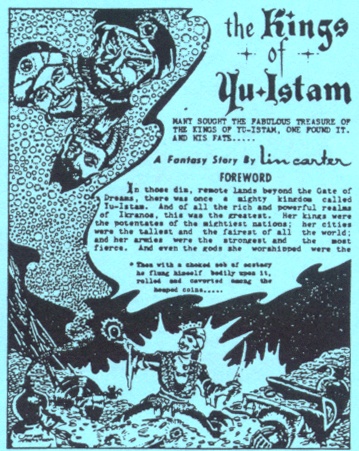
Tand 3 is a book-sized (92pp anyway) fanzine in the old style (right
down to the FiberTone paper) from Mark Manning, 1400 East Mercer #19, Seattle,
WA - 98112. Mark specifically refuses to take money for this, though a long list
of other acceptable inducements is given, including the usual copy of your own
zine. Excellent art, especially by Patrick Wynne and Taral. Good thing this
isn't a place where I review fanzines, I would probably go on too long about it.
It's nearly a year old now and probably no longer available anyway. But it does
refute Dave Hall's notion (in a recent letter) that there is no fandom left for
Arnie Katz to rejoin...
Don't seem to have had many letters from IGOTS #6... Here's one from Alan
Hecht, who actually encloses a $ and reminds me that I rejected his `xerographic
art'. Well, yes - as I remember it was extremely abstract, and not, to my taste,
even decorative. And it had large areas of black, which I could not have done
with my mimeo equipment anyway. Now I have about decided to do IGOTS by xerox
and use the mimeo for apazines, but I still don't care for this sort of abstract
art. I don't insist that art be a picture `of something' - I rather like the
dense patterns of Islamic and Celtic art - but these random lumps of light and
dark that are apparently supposed to represent some psychological state or
theory of composition leave me cold.
Adventures Unlimited, Box 22, Stelle, Illinois-60919, sends a nicely done
catalog of utterly cockamamie books about Atlantis, the `face' on Mars, "alien
bases" on the moon, and so on. They don't stop with books though - for the
seriously demented with a few loose bucks there are tours to "attempt to reach"
`El Moche Diablo' in Bolivia or the `lost city' of Colonel Fawcett (he lost it
in 1925) in Brazil or the megalithic remains of a `gigantic temple' in the
Kalahari Desert in Botswana. No mention of how the explorers are to be protected
from the drug dealers, guerillas, or local governments of these extremely
doubtful places!
Number Dictionary by Bruno Furst, Memory & Concentration Studies,
Chicago, 1946. And again in 1957... I suppose this little booklet must be part
of some larger system, but the use or value of it is hard to imagine. It
consists entirely of two sets of numbers, 00 through 099 and 1 through 1000 (in
order), each followed by one or more words. The words for any number often start
with the same letter, but not always. Not to choose a number at random, the
number `666' is followed by the rather infrequently used words `hashish-ash' and
`judgeship'. Some of the words are names - `Mitchell', for example, appears
under `365'. A lot of these words, though of obvious meaning, would not turn up
in conversation very often - "semi-shameful", "impaved", "maffick", "shadoof".
Even I don't know what `shadoof' is. Other words are quite common. On the
average, however, there are about 5 words per number, so there are only some
5000 words here altogether - a very limited vocabulary to include "maffick" and
"shadoof"!
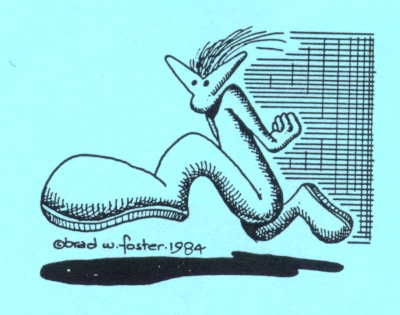
A David Spellman at Architectural Fantasies in Glendale, California,
writes to ask if I sell or rent my mailing list - he must be desperate to find
someone who wants a silly house! I can't remember if I bothered to
answer, but I certainly would not.
Rusty Burke, 12510 Manor Court, Houston, TX-77072, writes at some
length - "I've been meaning to drop you a line for some time now, to thank
you for senting IGOTS, a wonderfully literate and amusing zine {Ah,
egoboo! }. Never the best of correspondents (as certain long un-locced
faneds can attest), I have for past year been so heavily involved in Howardian
projects, both for REHUPA and for Necronomicon Press, that I've only gotten
worse. However, one of those projects now has the salutary effect of impelling
me to write, thus (I hope) keeping me on your mailing list.
First, the
"business", then some comments on the last IGOTS: I've given your name and
address to Billie Ruth Loving, the librarian in Cross Plains, as someone who
might be interested in hearing about their project to turn REH's house into a
museum, and who might be willing to get word to other fans. Basically, a local
civic group up there, Project Pride, made arrangements to purchase the house,
and are now seeking donations to help pay off the note (about $8500, I
understand, which is peanuts in Houston terms - and we have a depressed real
estate market), and to do some badly needed restoration work. I think if
everybody who ever read and enjoyed a Howard story sent a buck, they'd have
plenty of money for all the work they want to do. {See notice above for
Project Pride address. }
It's a chance for the local community there to
show that they do care about the hometown boy, and it's a chance for all of us
who are fans of REH to do something concrete to keep his memory alive in Central
Texas. A contribution of any size will no doubt be mightily appreciated. Fans
might also want to consider joining Project Pride: membership's only $3 a year
for individuals, $5 for families, and open to anyone. I'm signing up, as a way
of supporting what they're doing for Howard, and because, hell, I really like
Cross Plains. I've been there four or five times now, and will no doubt be back
many more times: I like the country and the people.
So, you should be
recieving some information from them soon, and I hope you'll be able to
contribute a little something to the cause, and I especially hope you can help
spread the word around to other fans. And if you have any other publicity ideas,
I hope you'll let me or the Project Pride folks hear 'em. {Sounds like a
worthy cause to me. I was never much for publicity ideas... I suppose it might
be possible to produce some photos or other graphics of the locale. }
And now a thought or several inspired by IGOTS 6:
If you still have a
copy of the REH Last Cat Book I'd like one - I have the original
Howard Collector appearance but there's no rest for the completist.
I dunno, "Multnomah" {the press that did The C S Lewis Hoax, reviewed
lastish } looks to me like it could be a Hebrew word. I can't find it
in any of my references though - perhaps some obscure Biblical name {But not
in Crudens Concordance - I see from the news about the Metzger trial that it's a
county name in the Seattle area }.
It seems to me that about one-third
of the books published these days are intended for the remainder tables -
which raises some questions in my mind about the economics of book publishing.
How come Bonanza can sell a 655-page book for less than half what a trade
hardcover sells for?
I think I understand Stanley Fish (as quoted by Marc
Ortlieb) - but then I've delved into Taoist and Buddhist thought. Probably just
as well that you engineering types go on pretending that objective reality
exists. Otherwise you'd give it up and go surfing, and we wouldn't have all
these neat gizmos. {If this PC clone and the zines I produce on it and the
books I comment on don't have `objective reality', it's certainly a very
elaborate delusion!}
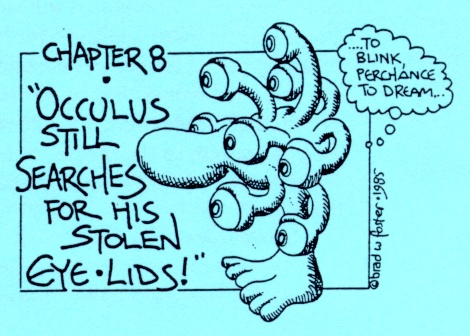
Regarding Harry Warner's comments about the dumping of library books: in all likelihood,
the person charged with buying books for the library thinks there will be
patrons interested in reading a particular tome (or using it, for reference
books). Some prove to be limited (or no) interest to patrons (librarians are
probably no better at prognostication than sports handicappers); others may have
seen some action for a time, but have outlived the interest. The library thus
turns the books over to AAUW for sale, the proceeds going to purchase newer
books. As to why they get rid of some books that you, personally, think
wonderful - well, where were you when the book was waiting to be checked out?
{Selling excess books is certainly preferable to destroying them, as they do
some places. I know I have seen books in libraries that it is unlikely anyone
would ever want. With modern computer links, it should be possible to check and
see if a book that no one has wanted lately, but that appears to be of possible
value, is still available through Inter-Library Loan. I have gotten several very
obscure things that way. }
I wonder if you or any of your readers can
help me locate the following books by Donn Byrne: The Stranger's Banquet
(Harper's, NY, 1919), The Foolish Matrons (Harper's, NY, 1920; Sampson
Low, Marston, London, 1923), The Wind Bloweth (Century, NY, 1922; Sampson
Low; Marston, London, 1922), Brother Saul (Century, NY, 1927; Sampson
Low, Marston, London, 1927), Stories Without Women (Hearst's
International Library, NY, 1915), Ireland, The Rock Whence I was Hewn
(Little, Brown, Boston, 1929; Sampson Low, Marston, London, 1929). I am also
interested in obtaining copies of magazines containing stories by, articles
about, or reviews of work by Donn Byrne. {I see that I have an even dozen of
the Byrne books, including both the British and US editions of The Wind
Bloweth, can't remember now if I sent Rusty anything. The two I have read
and enjoyed very much are Blind Raftery and Crusade. I have a
reading copy of Blind Raftery to spare. }
Am sending off
posthaste for Rants and Incendiary Tracts {Reviewed lastish },
which looks like my cup of bile. Enjoyed your sampler of vituperation, as well -
{Hunter} Thompson is my favorite journalist, and Generation of Swine
shows he hasn't lost his bite. {Aleister} Crowley's verse was delightfully
splenetic. Tournier's piece was interesting, but I don't care enough about
politics to waste the effort expended in shooting at politicians. The Archbishop
of Glasgow was a pretty fair curser, all right (by the by, should you ever run
across another copy of The Steel Bonnets {by MacDonald Fraser}, that's
the last item I need - unless one counts the hardcover Flashmans I'd love to
have but can't afford - for my George MacDonald Fraser collection), but the
Irish are a match for the Scots in such matters. You might get a kick out of the
following, an Irish rebel song called Nell Flaherty's Drake (`Nell
Flaherty' is a code name for Ireland, the `drake' is Robert Emmett, hanged for
leading an abortive uprising in 1803):
My name is Nell, quite candid I tell,
And I live near Cootehill, I will never deny;
I had a large drake, the truth for to spake
That my grandmother left me and she going to die.
He was wholesome and sound and he weighed twenty pound,
And the universe round I would roam for his sake;
But bad scram to the robber, be he drunken or sober,
That murdered Nell Flaherty's beautiful drake.
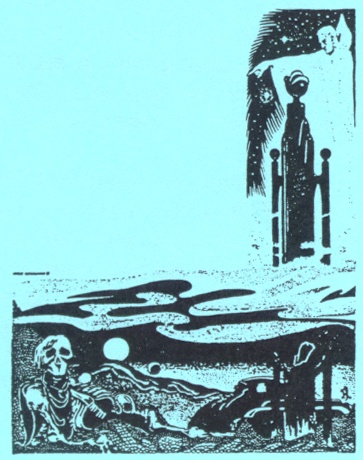
May his pig never grunt, may his cat never hunt,
That a ghost may him haunt in the dead of the night;
May his hen never lay, may his ass never bray,
May his goat fly away like an old paper kite.
That the flies and the fleas may the wretch ever tease,
And a bitter north breeze make him tremble and shake;
May an African bug build a nest in the lug
Of the monster that murdered Nell Flaherty's drake.
May his pipe never smoke, may his teapot be broke,
And to add to the joke, may his kettle ne'er boil;
May he ne'er rest in bed til the hour he is dead,
May he always be fed on goose grease and fish oil.
May he swell with the gout til his grinders fall out,
May he roar, bawl and shout with a horrid tooth ache;
May his temple wear horns and all his toes corns,
The scoundrel that murdered Nell Flaherty's drake.
May his spade never dig, may his sow never pig,
May each nit in his wig be as large as a snail;
May his door have no latch, may his house have no thatch,
May his turkey not hatch, may the rats eat his kale.
May every old faery from Cork to Dun Laoghaire
Dip him snug and hairy in some pond or lake,
Where the eel and the trout may dine on the snout
Of the hangman that murdered Nell Flaherty's drake.
May his dog yelp and growl with hunger and cold,
May his wife always scold til his brain goes astray;
May the curse of each hag who e'er carried a bag
Light on the wag till his beard it turns grey.
May monkeys still bite him and mad apes still fight him
And everyone slight him, asleep or awake;
May weasels still gnaw him and jackdaws still claw him,
The robber that murdered Nell Flaherty's drake.
(Lyrics from Blood on the Harp: Irish Rebel History In Ballad,
Turlough Faolain, Whitston Pub. Co., Troy, NY, 1983, pp.434-5; `Dun Laoghaire',
by the way, is pronounced "Dun Larry" or "Leary"). There are other verses I've
heard, but you get the idea. {Hard to imagine this being sung casually, as in
a pub, but it's a great curse... Rusty goes on a bit more yet (didn't you study
for the ministry, Rusty?), but we gotta move on! }
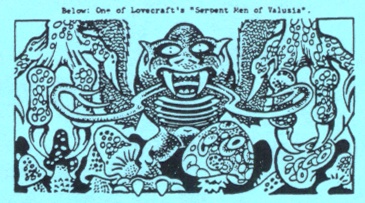
At Midnight on the 31st of
March by Josephine Young Case, Syracuse University Press, 1990, 144pp,
frontis, wraps, $9.95. Or so it says on the flyer they sent me (address, 1600
Jamesville Avenue, Syracuse, NY-13244-5160; $2 for the first, 0.50 each
additional book). I have the 1938 edition myself. A spooky booklength novel in
verse about a small town that wakes up to find the rest of the world (as far as
they can tell) has reverted to virgin wilderness. They note here that the story
was done on radio and television in the '60s - I must have missed it.
Lightning Flashes and Electric Dashes, ed. anon., W. J. Johnston, New
York, 1877, 144pp, illus. in woodcuts. This is subtitled "A Volume of Choice
Telegraphic Literature, Humor, Fun, Wit and Wisdom" and is an anthology
"contributed to by `All the principal writers in the ranks of telegraphic
literature, as well as several well-known outsiders". Not one of these people
have I ever heard of, but it's still a great book, full of the esoteric jargon
and peculiar practices of the telegraphers who tied the country together before
there were telephones or radio. The fiction and verse are in the ghastly turgid
style of the period, but the technical material is clear enough. The Calahan
woodcuts are wonderful cartoons. The final item is a parody of Shakespeare's
Julius Ceasar called The Carnival of Oshkosh. The publisher
apparently specialized in `telegraphic literature', as there are ads in the back
for two magazines in the field, Oakum Pickings (literary) and The
Operator (technical).
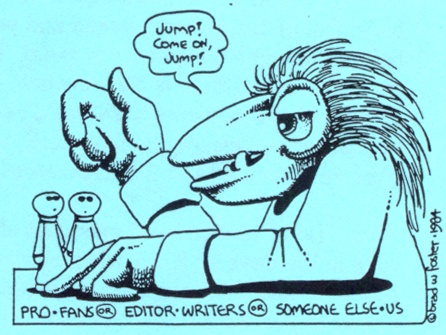
Don Franson (past president of the NFFF - I was a Director, but not
as long as he was president, back in the days of Karo, when everything was stuck
up) sends along two pages of fanzine reviews dated March'90 and mentions the
apparent demise of the fanzine as a literary art form. Prove him wrong - send a
copy of your fanzine to 6543 Babcock Avenue, North Hollywood, CA-91606.
The Illustrated Bradbury, by James Anderson, Niekas Publications,
Center Harbor, NH, 1990, 56pp, illustrated by Larry Dickison, wraps, $5.95. This
is saddle-bound along the 11-inch edge and only 4 inches wide. Address RFD 2,
Box 63, Center Harbor, NH-03226-9729. Very technical literary criticism, and the
art rather cold and stiff to my taste.
Obsessions by Anthony S. Magistrale, same publisher and format as
above item. Illustrated by Robert H. Knox, 40pp, $3.95. This one is poetry, with
an introduction by Robert Bloch. I don't find the poems very poetic, but some of
them are funny stories. The art is excellently macabre.
A Book of Ordinary Writings by Vichien Poonvoralak, Bangkok, Thailand,
1989, 20pp, wraps. This arrived quite unsolicited and when I sent a copy of
IGOTS and some comment, he sent another of the same. The rest of the address is
`1387/6 Tak Sin Road, Bukkalo, Bangkok'. The pages are very sparsely printed,
except for the first two, which provide a sort of bio/bibliography printed in
black and red from 1973 through 1988, notes that he lived in England from 1982
to 1987 and has a math degree from the University of Warwick. As for the rest,
it might as well be in Thai for all I can make of it. Rather depressing
semi-paradoxes. He's only 37, perhaps he will get over it.
Bill Bridget (1022 North Runyan Drive, Chattanooga, TN-37405) sends a
remarkable piece of fan-fold paper four sheets long, on which he has printed my
letter to him of a year ago, his reply, and some computer graphics and the logo
for a zine called The Incompleat Geometer, which all this is to be part
of eventually, or Real Soon Now, which ever comes first. No sign of it yet. He
either went to a lot of trouble taking paper in and out of the printer, or has
some clever software, as these sheets are printed on both sides and in both
directions. Since it is a galley of his fanzine, I can hardly reprint any of it
here, but it's all about Aristotle and the Pythagoreans and the Gnostics and
`pi' and naked drunks and, (though no one would expect it) the Spanish
Inquisition.
Ken Slater (Box 23, Upwell, Wisbech, Cambs. PE14 9BU, England), the place to
write for any British sf you might want, writes that "The March of Slime"
mentioned in IGOTS#6 was a tape-play made by the Liverpool Insurgent, a spoof of
fannish efforts to get to a convention. He says he isn't sure if it still exists
- I can assure him that it does, Harry Warner sent me a tape of it!
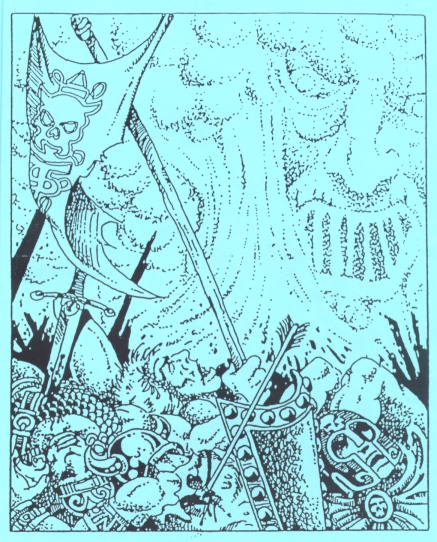
Cathy Doyle (26 D Copeland Lane, Newport News, VA-23601) accuses me of buying
up all the books (not that there were many) in the huckster room at the 1989
SciCon. This year, she says, a Richmond bookstore called Novel Futures is
to have a table at the con with nothing but books! What a novel (Cathy's
joke, I wouldn't say such a thing...) idea! I hope they make more money
at it than I ever did!
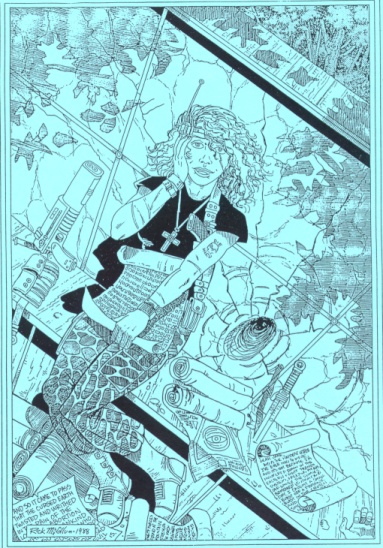
Music of the Spheres by Lotus Ray King, Saint Germain Press, Chicago,
1943, 32pp, wraps. This book of sheet music is the third of a set published by
the "I Am" movement, of which I know nothing much. The pieces in this one are
"Oh Helios - The Dawn", "Lord Maha Chohan", and "Seven Mighty Elohim". I see
that Donald Ray King and Godfrè Ray King are also involved in this business - I
never knew before that the Theosophists had hymnbooks...
Hymn of Asia by L. Ron Hubbard, Church of Scientology, Los Angeles,
1974, illus. with color photos and uncreditted line art. Speaking of theosophy,
here's ol' Elron as the fulfillment of the Buddhist prophecy that 2500 years
after Buddha a "red-haired or golden-haired man would arise in the West to
complete the job Buddha began". It's been so long they no longer know whether to
spell the fellow's name `Metteya' or `Metteyya' or `Maitreya', but whatever, Mr
Hubbard fills the bill, he shyly admits. Quite a large book, and nicely made,
but the text very sparse pseudo-guru in large (but beautiful) type. The color
photos are of rather sparse shrubbery, for the most part.
Chester D. Cuthbert (1104 Mulvey Avenue, Winnipeg, Manitoba, Canada) writes
at length about the Van Vogt book mentioned lastish, which I had sent him, and
the Guaranteed Annual Income and mentions in passing that Ken Ozanne bought
two copies of The Outsider as library discards in Minneapolis -
and I thought there were fans in Minneapolis!
Harry Warner (423 Summit Avenue, Hagerstown, MD-21740) notes that he has a
tape of The March of Slime mentioned lastish (which he later sent me). He
also makes fun of the Archbishop of Glasgow's spelling (Ghu will get you for
that, Harry), noting that his curse of the border reivers "from the top of their
head to the soil of their feet" is almost worthy of Rick Sneary, who no longer
makes inspired typos because he uses a spell-checker. Maybe there's still hope
for me, I refuse to have any stupid machine telling me how to spell.
Vanna Speaks by Vanna White, Books on Tape, Mississauga, Ontario,
1987, $9.95. I hope no one imagines that I bought this vile object, which
defames the name of `book'. I got it at the office, one of those parties where
everyone brings a gag gift. It boggles the mind to think who would have paid $10
(back in 1987, when money was still worth something) for this dismal thing -
especially if they were in Minneapolis and could have gotten The Outsider
at a library discard sale for much less.

Vern Clark (I'm
not sure I have a current address since he moved from Florida to Maryland)
writes, calling me `Uncle Ned', may his propellor-beanie seize up and twist his
head off at the neck:
Thanks for the recent batch of fanzines. Interesting reading your political
rantings. Always thought you were a Republican for some reason, obviously I was
wrong {hooha... } about that. Don't get me wrong, but most people who
work in the engineering profession are Republican. {Yeah, but I'm a
physicist... } I sure get a lot of flack for my own liberal viewpoint and
anti-Ollie North attitudes at times here at Martin Marietta. {Is this
Naughty Marrietta's brother? }
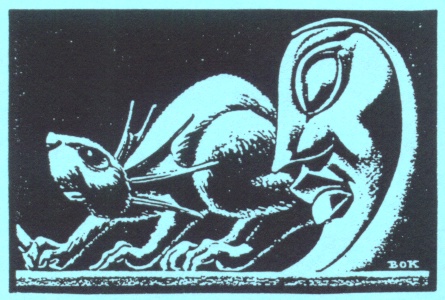
Enclosed is some
xeroxs {sic } of scattered artwork recently sent me by my friend Rick
McCollum for use in my fanzines. I doubt the readership of my zines and yours is
likely to cross paths, so you're welcome to use any of it in IGOTS. His address
is 440 Warner Street, Cincinnati, Ohio-45219. {Lovely stuff too, I will use
one or two of them, much thanks. }
By the way, the Bok piece in DREAMS #41 {Vern's REHUPA zine } was
from a fanzine not mentioned in your Hannes Bok checklist. Would you like to see
the zine? If so I'll give it to you. {Would I... Slobber, gasp, drool... Vern
doesn't mention the name of the zine in this letter, but I see it must be:
Scientifantasy , Vol.1, #3, Spring 1949, edited by Bill Kroll and
John Grossman in Des Moines, Iowa. In near-mint condition too! This zine
is reduced offset from right-margin-justified typescript (uncommon at that
time), 32 pages saddle-stapled in a tiny 4.25 by 5.5 inch format. Much excellent
art too, Jon Arfstrom and Jack Gaughan besides the Bok. Three pieces of fiction,
including one by the late Lin Carter, The Kings of Yu-Istam. I think I
will snitch some of this art for fillos, there is no copyright notice and I
can't imagine any of the people involved would mind after 40 years.
Ray Zorn writes to forgive me for misquoting him in IGOTS#6, he must be from
the Age of Phisterus, gets to write his age with an 8 now... He asks if I lump
John Moore in with Maurice Walsh and Donn Byrne - Walsh and Byrne are somewhat
similar at their best, though Walsh wrote a lot more crap in my opinion. But
Moore is mostly a nature writer and his novels very civilized and lacking in
thud & blunder, though in Mid-Summer Meadow the reader can hardly
help but wish that the good guys would roll up their sleeves, hoist the black
flag, and bust a few heads.
Avram Davidson writes (also calling me `Uncle Ned'!): I know very well
you didn't believe me about Terra Sigilata {Who, me - I believe twelve
impossible things before breakfast everyday! }, you didn't exactly say so
but the tone of scepticism was obvious. So I enclose a tearsheet from the
current NAT'L GEOG showing some examples of what it looked like. True, they are
not from Greece but Central America and nothing is said about aluminum silicate,
but the principle is the same and only a pedant would quibble. {I seem to
have lost the enclosure, but it was a photo of a clay tablet baked with a
`sigil' impressed, eaten by pilgrims to a Catholic shrine in Central America -
we had been discussing the eating of clay. } As it happens although when I
lived in Belize (then British Honduras) I never heard of them, but I did hear
about the pilgrimage to the Shrine of Esquipulas. A Gov't Medical Officer said
to me, "Every time we get malaria irradicated, someone brings it back from the
Pilgrimage to Esquipulas." That's what I call faith. The cultus of this Black
Christ was flourishing amongst the Mestizo people (locally called "Panyas" -
from Spaniards - but seldom to their faces as it had a certain derogatory
implication), with many candles lit and much rum drunk. I am sure the existence
of this Shrine and Cultus of a Black Christ will add ammo to the argument among
some Black people that Jesus was Black (whereas the Christian Identity Church
claims he was Anglo-Saxon), but the Belizeans gave another explanation, namely
that long ago an old church burned down and miraculously a wooden crucifix was
spared although it was blacked by the fire. They also added that "Esquipulas"
means `blisters' - I do not express any opinion about this. {The Archko
Volume quotes an Anglo-Saxonish description of Jesus by some contemporary
writer. }
As for your kaolin {I had sent him some lab-grade powder
from down near Macon, Georgia - I called the company who supplied it to
determine the value before I discarded the 5-lb bag some researcher had left
behind and learned that they give these bags away as samples - market value
about 7 cents/lb }, we added it to a milkshake and it was perfectly
delicious. It also cured scabs, scabies, falling hair, weak arches, and bumps on
the testicles (see Pliny the Elder). {I can't quite see Pliny from here, but
there was a fad (it recurred in Atlanta while I was in college there in the late
50s) for eating the white clay, of which this powder is the dehydrated dust,
direct from the creek bank. }
I will ask you to return the enclosed
clipping {Oh, that's why I don't find it... }, which now fetches 37 cents
in good condition. Thank you for a recent fanzine, which had absolutely the
worst fanzine cover art since the death of poor Phil Harrell, unkindly
called the Crudzine King. {I didn't know you knew Harrell... The first zine I
ever got from him certainly had a bad enough cover, his own depiction of the
walking haystack called `The Harrelling BEM'.}
I have no more to add,
and shall mail this in a furtive manner, as I am being shadowed by followers of
the Christian Identity Church as well as agents of the Church of the Black
Buddha...what?... you didn't know ? Dr. W. E. B. Du Bois assures us, in
his little book, The Negro, c.1918, that those aren't either
snails on the head of the Buddha in all the images and illoes, no-ho-ho:
they are curls . I incline to think that this makes as much (or as
little) sense as the story that there are snails on his enlightened pate (the
snails crawled there to shade him). I hope you don't think I made that up about
Dr. Du Bois, it is there in his little book, and despite the snails and a few
other lapses from good sense, it is an interesting little book. I do not think
that world Buddhism has been converted to the Negro notion, but this just goes
to show you the power of prejudice. I didn't know there were Negroes in Nepal
(birthplace of Gautama Siddhartha B.), but there's a lot I didn't know and don't
know. So chain up your curb and get with it. {Aye aye, sir! }
Typing completed October 23, 1990 -

Merry Christmas to All
And a Happy New Year!
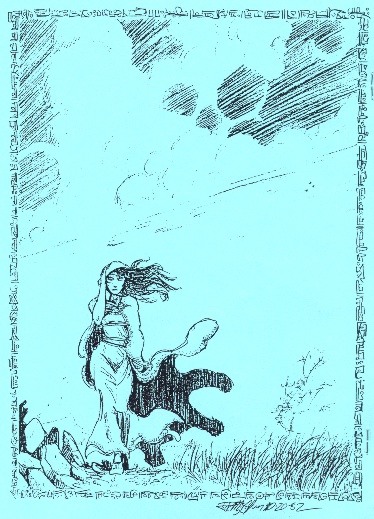
Return to INDEX















